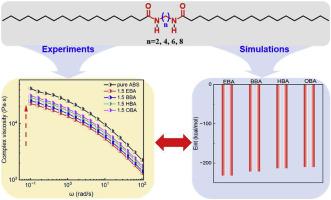Our official English website, www.x-mol.net, welcomes your
feedback! (Note: you will need to create a separate account there.)
The relationship between the structure of stearic acid diamide lubricants and the lubrication properties in acrylonitrile-butadiene-styrene resins
Polymer ( IF 4.1 ) Pub Date : 2024-07-09 , DOI: 10.1016/j.polymer.2024.127378 Xiang Sun , Huilin Hu , Ning Kang , Zhenbiao Song , Shulai Lu , Shicheng Zhao
Polymer ( IF 4.1 ) Pub Date : 2024-07-09 , DOI: 10.1016/j.polymer.2024.127378 Xiang Sun , Huilin Hu , Ning Kang , Zhenbiao Song , Shulai Lu , Shicheng Zhao

|
Although amide lubricants are commonly used as lubricants for acrylonitrile-butadiene-styrene (ABS) resins, the relationship between their structure and lubricating properties remains unclear. In this paper, a series of stearic acid diamide lubricants for ABS resins were synthesized through an amidation reaction with the stearic acid and aliphatic diamines. The chemical structure was characterized by FTIR and H NMR. A detailed evaluation of the lubrication effect of the lubricant was carried out by dynamic mechanical analysis, rotational rheometry, contact angle measurements, and so on. The results showed that the complex viscosity, glass transition temperature and diamine's alkyl chain length of stearic acid diamides were positively correlated, while the elongation at break displayed a negative correlation. Compared to ethylenediamine bis stearate acid (EBA), 1,8-diaminooctane bis stearate acid (OBA) exhibited a 37.8 % increase in the complex viscosity at 0.1 rad/s, along with a 4.6 % rise in the glass transition temperature. It was indicated that the lubrication effect of stearic acid diamides deteriorated with the increase of the alkyl chain lengths of diamines. The lubrication mechanism was further validated by molecular dynamics simulations. As the alkyl chain lengths of diamines increased, the mean square displacement and interaction energy of the system exhibited a tendency to become lower and higher, respectively. This meant that the longer alkyl chains of the diamines in the lubricants were not advantageous to the free mobility of the matrix molecular chains. These findings provided insightful guidance for the sensible design of lubricants for ABS resins.
中文翻译:

硬脂酸二酰胺润滑剂结构与丙烯腈-丁二烯-苯乙烯树脂润滑性能的关系
尽管酰胺润滑剂通常用作丙烯腈-丁二烯-苯乙烯(ABS)树脂的润滑剂,但其结构和润滑性能之间的关系仍不清楚。本文通过硬脂酸与脂肪二胺的酰胺化反应合成了一系列用于ABS树脂的硬脂酸二酰胺润滑剂。通过 FTIR 和 1H NMR 对其化学结构进行了表征。通过动态力学分析、旋转流变测量、接触角测量等对润滑剂的润滑效果进行了详细评价。结果表明,硬脂酸二酰胺的复数粘度、玻璃化转变温度与二胺烷基链长度呈正相关,而断裂伸长率呈负相关。与乙二胺双硬脂酸 (EBA) 相比,1,8-二氨基辛烷双硬脂酸 (OBA) 在 0.1 rad/s 下的复数粘度增加了 37.8%,玻璃化转变温度增加了 4.6%。结果表明,硬脂酸二酰胺的润滑效果随着二胺烷基链长度的增加而变差。通过分子动力学模拟进一步验证了润滑机制。随着二胺烷基链长度的增加,体系的均方位移和相互作用能分别呈现出降低和升高的趋势。这意味着润滑剂中二胺的较长烷基链不利于基质分子链的自由流动。这些发现为 ABS 树脂润滑剂的合理设计提供了富有洞察力的指导。
更新日期:2024-07-09
中文翻译:

硬脂酸二酰胺润滑剂结构与丙烯腈-丁二烯-苯乙烯树脂润滑性能的关系
尽管酰胺润滑剂通常用作丙烯腈-丁二烯-苯乙烯(ABS)树脂的润滑剂,但其结构和润滑性能之间的关系仍不清楚。本文通过硬脂酸与脂肪二胺的酰胺化反应合成了一系列用于ABS树脂的硬脂酸二酰胺润滑剂。通过 FTIR 和 1H NMR 对其化学结构进行了表征。通过动态力学分析、旋转流变测量、接触角测量等对润滑剂的润滑效果进行了详细评价。结果表明,硬脂酸二酰胺的复数粘度、玻璃化转变温度与二胺烷基链长度呈正相关,而断裂伸长率呈负相关。与乙二胺双硬脂酸 (EBA) 相比,1,8-二氨基辛烷双硬脂酸 (OBA) 在 0.1 rad/s 下的复数粘度增加了 37.8%,玻璃化转变温度增加了 4.6%。结果表明,硬脂酸二酰胺的润滑效果随着二胺烷基链长度的增加而变差。通过分子动力学模拟进一步验证了润滑机制。随着二胺烷基链长度的增加,体系的均方位移和相互作用能分别呈现出降低和升高的趋势。这意味着润滑剂中二胺的较长烷基链不利于基质分子链的自由流动。这些发现为 ABS 树脂润滑剂的合理设计提供了富有洞察力的指导。











































 京公网安备 11010802027423号
京公网安备 11010802027423号